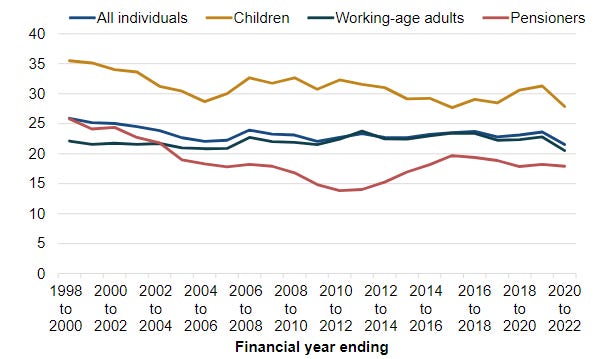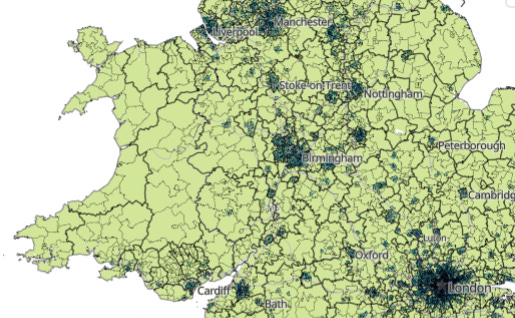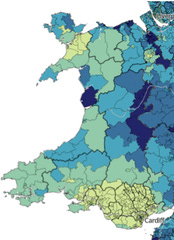The maps you need to see to really understand Wales
Policy makers hide behind how complex our problems are. Understanding these issues is the first stage in holding them to account
Happy New Year and welcome to everyone who was gifted this subscription for Christmas - you are in for a treat (or a living hell depending on your interests I guess).
We are going to jump straight into it by looking at some big issues facing Wales and how we can better understand them.
But before we do I just want to say that you can now get a 75% discount when you sign up for a paid version of the newsletter. You can do that by clicking on this link. This really helps support this kind of journalism.
How do you solve a problem like Cymru?
Wales will soon have a new First Minister. He (it is definitely going to be a bloke) is going to inherit some huge long term challenges. If he's anything like his predecessors, he is going to really struggle to fix them.
These are really complicated problems, and anyone who tells you there are simple solutions to complicated problems is usually being disingenuous (see Brexit). But decision-makers are able to hide behind the complexity of these problems because it is hard to hold people to account when issues are multifaceted.
Let's start with poverty. This is hard to do exactly when it comes to figures because it all depends on how and when you are measuring it plus there was a pandemic thrown into the mix (I plan on using a future newsletter to talk about the ridiculous way the UK Government measures poverty). But let’s do some ball park figures:
- Roughly 600k children live in Wales
- Of those, just under one in three, or 200k, are in poverty (in households at or below 60% of median income).
- 90k are living in severe poverty (below 50% of median income).
There are a higher percentage of children in poverty than any other age groups:
Taking a look at the map below, you might think poverty is a Valleys problem (the dark bits to the north of Cardiff in the SE).
While it is true there are challenges in the Valleys, just working on that assumption is to massively miss the issue.
To understand we need to look closer.
The map here is all 1,909 LSOAs (400 to 1,200 households) in Wales ranked based on income.
These next two maps show the Valleys and Cardiff respectively.
As you can see, there are pockets of the Valleys which have pretty decent incomes, and parts of the Welsh capital that are incredibly deprived.
In fact, the poorest part and the richest part of Wales are right next to each other! If you stand on Fitzhamon Embankment looking east across the River Taff in Cardiff you are looking over a billion pounds of investment (the Principality stadium, BBC building, site of the former Brains brewery etc). But behind you is south Riverside where more than half of the kids live in poverty. I actually spent a month there a year ago which you can read about here.
My point is that poverty is complex, multifaceted and entrenched.
The other thing to say is that while Wales isn't unique in having a poverty issue, it does have a bigger poverty problem than other parts of the UK. This graph shows food bank use in Wales:
This doesn’t look good for the Welsh Government, but of course they will argue that it isn’t fair to compare Wales with England which is so much bigger and has large pockets of wealth. Well unfortunately for them the argument falls flat when we compare Wales to regions of England where Wales is still highest in terms of food bank use.
So let’s have a look at jobs in Wales. The map below shows the percentage of households in an area which have no-one in employment.
The darkest area is Blaenau Gwent where almost a quarter of households have no-one working.
Of course unemployment doesn't help poverty but this really isn't just an issue of unemployment. The Joseph Rowntree Foundation figures show the majority of people who are in poverty are also in employment.
Often it is the quality and pay of the jobs that people are in that are the issue. So how can we get Wales out of the poverty spiral? Better education and transport perhaps...
We have already talked about how the UK Government has shortchanged Wales when it comes to rail investment in previous newsletters.
When it comes to education things are also not good, as the recent Pisa results showed (though there are reasons to take those scores with a pinch of salt).
The map below shows the amount of people who don't have any qualifications of NQF level 2 (GCSE) or above. In Merthyr for example, close to one in five don't have that level of qualification. This makes it hard to tackle the poverty issue.
Old and ill
Let's move away from poverty to look at age and health.
Take a look at the 2 maps below.
The 1st shows the amount of people over 65 (the darker it is, the higher the % of older people). The 2nd shows population density (the lighter the colour the more spread out the people.
From these you can learn several things:
Wales is FAR less densely populated than England.
Wales has a significantly older population than England (not least because so many English people retire here).
The areas of Wales that are the oldest are the least densely populated
Older people are more likely to need public services like health and social care. But in Wales, lots of these people are very spread out.
This means it is more expensive to provide care and support for the same number of old people in Wales as it would be in England.
This massively contributes to the pressure on Wales' public services.
Language identity and second homes
Second homes are a huge issue in some parts of Wales.
The sheer volume of second homes means that local people are priced out and unable to buy in their local area. This then reduces numbers in schools, which leads to closures which in turn forces more local people to move out.
It is a vicious cycle.
This map shows the breakdown of second homes by local authority.
As you can see, in places like Gwynedd an astonishing 30% of dwellings are second/holiday homes. This is followed by Pembrokeshire and Ynys Mon.
If we break the data down to a more local level in the next map you can see where the concentrations are. Frustratingly there is no data at this level for Swansea and Pembs.
However, beyond the impacts on services, the second homes surge has been devastating for the Welsh language.
Look at the map below which shows the percentage of people in an area that speak Welsh.
It is almost like for like with the map showing where the most second homes are. These areas have been the engine room and safeguard to Cymraeg for centuries but are now under real threat.
National identity in Wales is a strange thing.
The younger you are the more likely you are to identify as Welsh rather than British, whereas older people are more likely to identify themselves as British and Welsh.
This impacts on politics, outlook and often voting intention.
This map shows the percentage of people who identify only as Welsh (darker colours mean higher numbers)
However, people identifying as both Welsh and British are far more likely to live in areas in south Wales around the capital.
You can see that on this map:
If you instead just look at people who identify as only English you can see how interconnected parts of north Wales are especially with Merseyside.
I appreciate that this was a bit of a map and graph binge. But I think it is really hard to understand Wales and its challenges without understanding the demographics that underpin them.
I will finish with a request. If you wouldn’t mind feeding back to me how you are finding the newsletter I would really appreciate it. Does it need to be shorter? More broken up with a variety of content? Interviews with people etc?
I want to make this as good as it can be and given that this is your newsletter I would love your feedback.
Take care
Will























I'm appreciating your newsletters. Thanks for setting out these issues. The Welsh gov has developed strategies for dealing with these problems. Could you assess the progress they have made in implementing them.
Really enjoy reading the newsletters - the deep,kind of left field, delve into specifics, like this map fest, is always interesting.